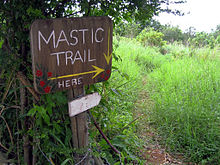Mastic Reserve
Description
Mastic Reserve is an 834 ha tract of mainly forested land. It is bounded on the south and west by the Central Mangrove Wetland, and on the north by farmland. It encompasses the largest tract of contiguous native dry forest in the Cayman Islands, as well as the highest part of the low-lying island, with an elevation of 18 m. It also includes stands of royal and silver thatch palms as well as abandoned agricultural land, now grassland.
Mastic Trail

The Mastic Trail is based on a traditional footpath that had fallen into disuse. In 1994 and 1995 it was restored and reopened as a 4 km walking track that passes through the reserve, traversing the central part of Grand Cayman from south to north. The southern part includes a 170 m hand-built rock causeway, known as the “Mastic Bridge”, through black mangrove forest.
Birds
The IBA was identified as such by BirdLife International because it supports significant populations of white-crowned pigeons, Cuban amazons, Caribbean elaenias, thick-billed vireos, Yucatan vireos and vitelline warblers. Other birds found in the reserve include West Indian woodpeckers and Caribbean doves.
References
- ^ "Mastic Reserve". Important Bird Areas factsheet. BirdLife International. 2014. Retrieved 2014-04-03.
- ^ "Mastic Reserve & Trail". National Trust for the Cayman Islands. 2014. Archived from the original on 2014-04-07. Retrieved 2014-04-04.
19°19′00″N 81°11′00″W / 19.31667°N 81.18333°W